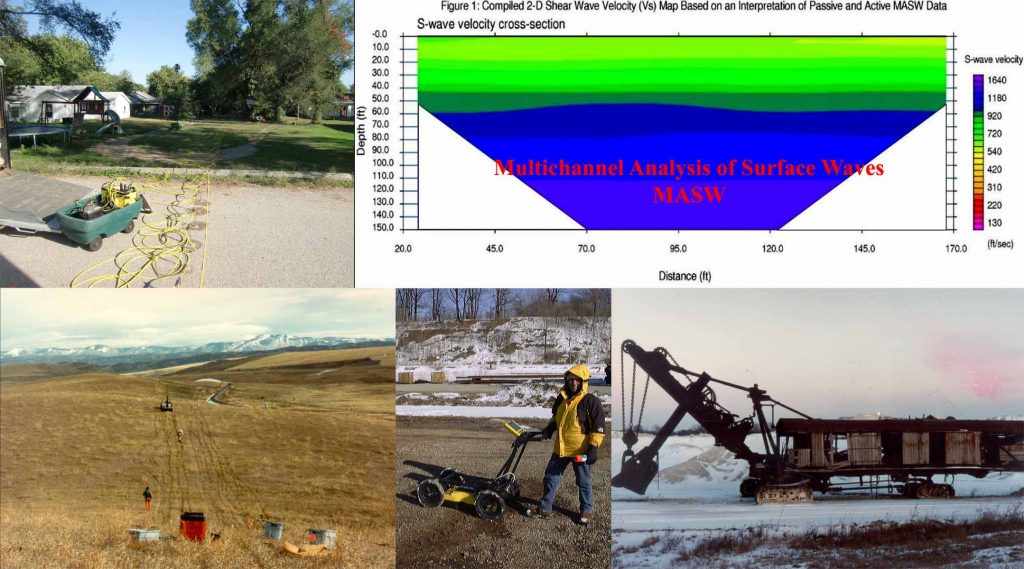A geophysics survey
with one or more geophysical instruments
can non-destructively map or image the subsurface. Geophysical services are available here through Find a Geophysicist for Engineers, Geologists, Mining, and Archaeology. Sensors & Software’s Conquest, Noggin, and PulseEKKO Pro are state of the art ground penetrating radar GPR systems. The systems record the response of a transmitted electromagnetic pulse through various materials, much like one sees on the screen of a fish locator. Earth resistivity imaging with AGI’s SuperSting multi-electrode resistivity system yields 2-D and 3-D images of the subsurface (Find resistivity imaging services and soil resistivity testing equipment for rent). Geometrics capacitance coupled OhmMapper electrical resistivity array is towed to cover spatially large areas. These systems yield the apparent resistivity of various depths of penetration for 1000’s of locations during a geophysics survey. Locating buried metal or mapping soil conductivities over large sites are achieved with Geonics EM-61 EM-38 EM-34 EM-31 and Protem electromagnetic instruments. Geophysical surveys using multichannel analysis of surface waves MASW, seismic reflection, or seismic refraction methods analyze how the elastic properties influence the the response of the propagation of seismic waves through fluids, soils, and rock. A Geometrics Geode seismograph with geophones works well to record the response. Ground vibrations from blasting, pile driving, dynamic soil compaction, earth moving, and other large objects impacting the earth are often recorded with an Instantel ground vibration monitor. The ground vibration monitor consists of a seismograph and geophone (sometimes an accelerometer) specifically designed for this application. While magnetometers are great for locating shallow buried iron complex arrangements of buried cables, pipes, or other types of lines are traced using underground utility locators.
Geophysicists, geologists, and engineers
often investigate spatially large areas with a geophysics survey
to map buried drum disposals, Superfund sites, frac sand, sand and gravel deposits, landfills, buried waste, a levee ( visit aLevee.com), faults, joints, fractures, karst features, bedrock, groundwater contamination, variations in ground or earth resistivities, soil thickness, and the properties of groundwater aquifers. Characterizing soil conditions over a farm field is called agricultural geophysics. A geophysics survey can assist with improving crops.
Archaeologists and forensic scientists
generally focus on geophysical methods that detail smaller regions.
Graves, fire pits, waste pits, debris, metal, and building structures are of interest at archaeological sites. High resolution methods can uncover great detail. Like most archaeological investigations or digs, the amount of detail is usually directly related to the amount of time spent during the investigation. Archaeogeophyiscal methods can take days or weeks to acquire the data needed to characterize a relatively small area.
Drillers, Excavators, and Construction personnel
may utilize a geophysics survey to assist with locating specific targets.
Many times they are interested in locating underground utilities. Imaging post tension cables, power, pipes, reenforcing bars rebar, wire mesh, sewers, voids, cracks, and the thickness of concrete is a discipline of geophysics that is often done by a concrete scanner (try Use a Concrete Scanner to Scan Concrete With Ground Penetrating Radar GPR See Cables, Pipe, Rebar, and Post Tension Cables). At times, customers may call concrete scanning X Ray. These specialized disciplines of geophysics depend on mapping the EM response radiated from a conductor like a wire or a pipe. Some site conditions can lead to a complex response that misplaces or does not detect the target. With this in mind, any penetration made into the subsurface should be done with the greatest of care since not detecting a target of concern does not guarantee there isn’t one at depth. However, this lack of a guaranteed locate should not give permission to instrument operators to do a poor job or to not take the time to explain the limitations of the technology to the client.







2 thoughts on “A Geophysics Survey From GeophysicsSurvey.com”
Excellent post, I had to do the same in my PhD, which partly led to the rceraesh I do now. I really think that most people just press the button in RES2DINV and plot (and overinterpret) the result. At least that’s the impression you get from looking at conference posters. But just looking a bit into the parameters gives you valuable information on reliability of your inversion, and there’s really options that can help interpretation.
Leny, your comment about RES2DINV was routed into the geophysics spam box. Sorry, at least I found it before it was lost forever. I am glad to see you are doing research. What type of research are you doing that you are using geophysics or multielectrode electrical resistivity methods?
Comments are closed.